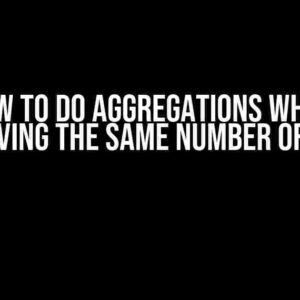Are you tired of wrestling with complex data sets, struggling to extract actionable insights from your ManyToMany relationships? Do you dream of effortlessly aggregating and grouping data to unlock hidden patterns and trends? Look no further! In this comprehensive guide, we’ll delve into the world of complex GroupBy aggregation with cartesian product of multi-dimensional data over ManyToMany fields. Buckle up, because we’re about to take your data analysis skills to the next level!
What is GroupBy Aggregation?
Before we dive into the meat of the matter, let’s quickly review what GroupBy aggregation is all about. GroupBy is a fundamental concept in data analysis that allows you to group data based on one or more common attributes, and then perform aggregation operations on those groups. In other words, it enables you to:
- Segment your data into meaningful clusters
- Calculate summary statistics (e.g., sum, average, count)
- Identify patterns and relationships within and across groups
Simple GroupBy aggregation is a breeze, but things get interesting when you introduce ManyToMany relationships into the mix. That’s where our journey begins.
ManyToMany Relationships and the Cartesian Product
In a ManyToMany relationship, each record in one table can be related to multiple records in another table, and vice versa. This creates a vast, interconnected web of data that can be challenging to navigate. To tackle this complexity, we need to employ the cartesian product.
The cartesian product, also known as a cross-join, is a mathematical operation that combines every element of one set with every element of another set. In the context of ManyToMany relationships, this means we’ll generate a new table with every possible combination of records from both tables. Sounds daunting? Don’t worry, we’ll break it down step by step.
Example: ManyToMany Relationship with Authors and Books
Let’s consider a simple example to illustrate the concept. Suppose we have two tables: `authors` and `books`. Each author can write multiple books, and each book can have multiple authors.
| Authors | Books |
|---|---|
| Alice | Book A, Book B |
| Bob | Book B, Book C |
| Charlie | Book A, Book C |
To perform a cartesian product on these tables, we’d generate a new table with every possible combination of authors and books:
| Author | Book |
|---|---|
| Alice | Book A |
| Alice | Book B |
| Bob | Book B |
| Bob | Book C |
| Charlie | Book A |
| Charlie | Book C |
Now, imagine we want to calculate the total number of books each author has written. We can use GroupBy aggregation to achieve this.
Complex GroupBy Aggregation with Cartesian Product
With our cartesian product table in hand, we can apply GroupBy aggregation to calculate the desired metrics. In this case, we want to count the number of books each author has written.
SELECT author, COUNT(DISTINCT book) AS num_books FROM cartesian_product_table GROUP BY author
This query will produce the following result:
| Author | num_books |
|---|---|
| Alice | 2 |
| Bob | 2 |
| Charlie | 2 |
Voilà! We’ve successfully applied complex GroupBy aggregation with cartesian product to our ManyToMany relationship. But wait, there’s more!
Multi-Dimensional Data and Additional Grouping Columns
In many cases, our data is multi-dimensional, meaning we have multiple columns that we want to group by simultaneously. Let’s extend our previous example to include an additional column, `genre`, which categorizes each book into a specific genre (e.g., fiction, non-fiction, biography).
| Author | Book | Genre |
|---|---|---|
| Alice | Book A | Fiction |
| Alice | Book B | Non-Fiction |
| Bob | Book B | Non-Fiction |
| Bob | Book C | Bibliography |
| Charlie | Book A | Fiction |
| Charlie | Book C | Bibliography |
To calculate the number of books each author has written in each genre, we’ll add the `genre` column to our GroupBy clause:
SELECT author, genre, COUNT(DISTINCT book) AS num_books FROM cartesian_product_table GROUP BY author, genre
This query will produce the following result:
| Author | Genre | num_books |
|---|---|---|
| Alice | Fiction | 1 |
| Alice | Non-Fiction | 1 |
| Bob | Non-Fiction | 1 |
| Bob | Bibliography | 1 |
| Charlie | Fiction | 1 |
| Charlie | Bibliography | 1 |
By adding the `genre` column to our GroupBy clause, we’ve effectively created a multi-dimensional grouping that allows us to analyze the number of books each author has written in each genre.
Real-World Applications and Use Cases
Complex GroupBy aggregation with cartesian product of multi-dimensional data over ManyToMany fields has numerous real-world applications:
- Product recommendations: Analyze customer purchases to recommend products based on item relationships.
- Social network analysis: Study user interactions to identify patterns and relationships in social media platforms.
- Customer segmentation: Group customers based on demographics, behavior, and preferences to target marketing campaigns.
- Supply chain optimization: Analyze inventory, shipping, and supplier relationships to optimize logistics and reduce costs.
These examples illustrate the power of complex GroupBy aggregation in unlocking actionable insights from complex data sets.
Conclusion
In this comprehensive guide, we’ve demystified the complex GroupBy aggregation with cartesian product of multi-dimensional data over ManyToMany fields. By mastering this technique, you’ll be able to:
- Effortlessly navigate ManyToMany relationships
- Perform complex GroupBy aggregation with ease
- Unlock valuable insights from multi-dimensional data
Remember, practice makes perfect. Experiment with different scenarios, and soon you’ll be a master of complex data analysis.
Frequently Asked Question
In the realm of data manipulation, complex groupby aggregations with cartesian products can be a daunting task, especially when dealing with multi-dimensional data and ManyToMany fields. But fear not, dear reader, for we’ve got the answers to your most pressing questions!
What is a ManyToMany field, and why is it a challenge for complex groupby aggregations?
A ManyToMany field is a relationship between two models where each instance of one model can be related to multiple instances of the other model, and vice versa. This creates a complex web of relationships, making it challenging to perform groupby aggregations that involve cartesian products. The resulting data explosion can lead to performance issues and difficulties in data analysis.
How do I perform a cartesian product in Django ORM with a ManyToMany field?
In Django, you can perform a cartesian product using the `prefetch_related` method, which allows you to fetch all related objects in a single database query. For example, `ModelA.objects.prefetch_related(‘many_to_many_field’).all()` will fetch all related objects in the ManyToMany field. You can then use `annotate` and `values` to perform the desired groupby aggregation.
What is the difference between a ManyToMany field and a ForeignKey in Django?
A ForeignKey represents a many-to-one relationship, where each instance of the model is related to a single instance of another model. A ManyToMany field, on the other hand, represents a many-to-many relationship, where each instance of the model can be related to multiple instances of another model, and vice versa.
How can I optimize complex groupby aggregations with cartesian products in Django?
To optimize complex groupby aggregations, use `prefetch_related` to minimize database queries, and consider using database indexing on the related fields. You can also use `annotate` with `F` objects to perform calculations on the database side, reducing the amount of data transferred. Lastly, consider using a more efficient database engine, such as PostgreSQL, which supports more advanced aggregation functions.
Can I use Django’s built-in aggregates with ManyToMany fields?
Yes, you can use Django’s built-in aggregates, such as `Count`, `Sum`, and `Avg`, with ManyToMany fields. However, you’ll need to use `annotate` with `values` to specify the ManyToMany field as part of the groupby operation. For example, `ModelA.objects.annotate(count=Count(‘many_to_many_field’)).values(‘many_to_many_field’, ‘count’)`.



